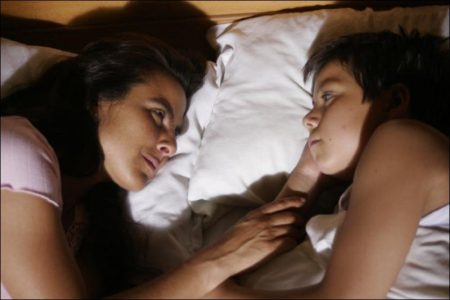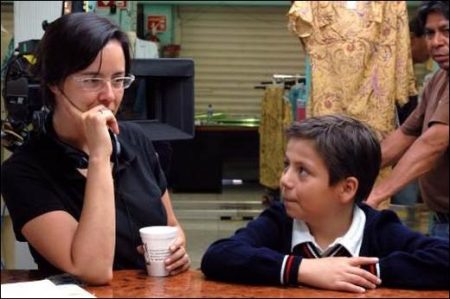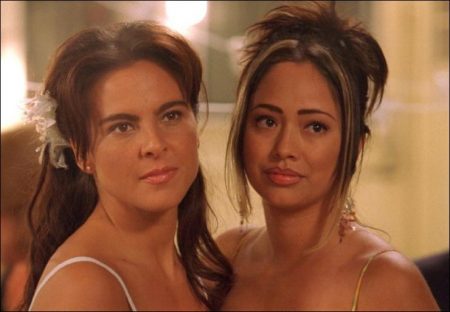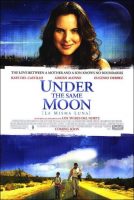Tagline: The love between a mother and a son knows no boundaries.
Nine-year-old Carlos aka Carlitos (Adrián Alonso) is one of the countless children left behind by parents who come to the U.S. seeking a way to provide for their families. His mother, Rosario (Kate del Castillo) has worked illegally as a domestic in Los Angeles for four years, sending money home to her son and mother to give them a chance at a better life.
When the death of his grandmother leaves young Carlitos alone, he takes his fate into his own hands and heads north across the border to find his mother. As he journeys from his rural Mexican village to the L.A. barrio, Carlitos faces seemingly insurmountable obstacles with a steely determination and unfettered optimism that earn him the grudging respect and affection of a reluctant protector, a middle-aged migrant worker named Enrique (Eugenio Derbez).
The unlikely pair finds its way from Tucson to East L.A., but the only clue Carlitos has to his mother’s whereabouts is her description of the street corner from which she has called him each Sunday for the last four years. Unaware that Rosario is only hours away from returning to Mexico to be with her son, Carlitos and Enrique desperately comb the vast unfamiliar city for a place he has seen only in his imagination.
Under the Same Moon (Spanish: La misma luna) is a 2007 Mexican-American drama film in Spanish and English directed by Patricia Riggen and starring America Ferrera, Adrian Alonso, Jesse Garcia, Kate del Castillo, Eugenio Derbez, Maya Zapata, Carmen Salinas, María Rojo, Angelina Peláez, Ignacio Guadalupe, Mario Almada.
The Making Of Under The Same Moon
A sensitive examination of the emotional cost of illegal immigration, Under the Same Moon (La Misma Luna) is also a bittersweet love story of a mother and son whose connection is sustained over too many years and too many miles of separation. Director Patricia Riggen is delighted by the way the film has been received at early screenings, including its Sundance premiere. “It is a small movie, without pretensions, and full of heart. The most gratifying thing for me is to see the public reaction. I love to see them laugh, see them cry. It’s not only that they were entertained but that hopefully the meaning of the work will stay with them.”
For Riggen, the essence of the film is the reality of the Mexican migrant. At a time when an estimated 4 million Latino women have left at least one child behind as they work in the US, she sees only one explanation. “The only reason they do it is love. Love for parents, children, family, brothers and sisters, to be able to pay school fees. This for me is something very beautiful. The Mexican migrant is very generous, heroic. They are the first audience targeted by the movie, their wants, what moves them, their dreams, their fears. All their sentiments, all their emotions, all their diversions, because this is about them and this is for them.”
Riggen, whose previous credits include the prize-winning documentary Family Portrait, first read the script for Under the Same Moon (La Misma Luna) after a mutual friend introduced her to the film’s writer, Ligiah Villalobos. The script possessed a passion and universality that immediately intrigued the director. “The love story between mother and child lends itself to big emotions, which are something cinema is very good at conveying,” she says. “Even though this movie is very Mexican, I believe that people of any nationality will identify with the theme. The relationship between mother and son has no nationality.”
When Villalobos began writing the script more than five years ago, immigration had not yet become the burning, front-page national issue it is today. The writer was more interested in exploring the way everyday people deal with an emotionally wrenching situation than making a political statement. “This is a story of a young boy who was abandoned by his parents for the purpose of giving him a better future,” she explains. “You don’t need to be a Mexican or an illegal immigrant to be able to relate to this film.”
The title, which translates literally to “the same moon,” has a double meaning in this movie, according to Riggen. “One is the universal moon that we all see, no matter where we are in the world; no matter which side of the border we’re on. With the debate on immigration taking place now, it is good to remember that we are all under the same moon. The other is something Carlitos’ mom told him before she left to go to the US; that whenever he felt lonely, he should just look at the moon and know that she would be looking at it too.”
Villalobos and Riggen spent a year working together on the script, revising, restructuring and polishing it, in a process complicated by geography: Villalobos spends most of her time in New York City, while Riggen lived in Los Angeles, requiring much of the collaboration be done by telephone. It was a labor of love for Villalobos, a successful television writer and producer who worked on the script at night after putting in 12-hour days at her network job.
For her the key to the story was to approach it from the perspective of the child. “I wanted to try to look deep down inside a kid’s heart at what he really feels when someone close to him leaves him behind to go to another country to provide a better life for him,” she says. “I would ask, does he have to be offered the best life money can buy? Or is it better that the family stay together despite monetary problems?
“Carlitos makes a decision using his heart,” observes the writer. “He leaves behind everything that was provided to him all these years by his loved ones. He is leaving his friends, family, and country behind for the sole reason of reuniting with his mother. He’s not thinking of what would happen to him, and he’s not at all afraid, despite his age-or perhaps because of it.”
***
With the finished screenplay in hand, Riggen put on her director’s hat and began to dig even deeper into the inner life of the story she had helped create. “My biggest discovery was that all the characters were acting out of love and that idea resonated so much with me that I decided to make it the theme of the movie.”
Riggen says she went as far as to write the premise down in order to keep it front and center throughout the project: “Illegal immigrants risk everything when they cross the border. They leave their loved ones and even put their lives at risk. And they do it just for one reason: the love they have for their families.”
The director knew that finding the right child to play Carlitos was a make or break proposition for the film. The role of Carlitos required finding a very young actor with the ability to convince an audience that, as innocent as he is, he is capable of making one of the most perilous trips in the world alone. Adrián Alonso (The Legend of Zorro) had what she needed – and more. Alonso displays a wrenching emotional honesty in the role of an indomitable little boy whose resolve to reunite with his mother gives him the courage to face impossible odds.
With five feature films under his belt, Alonso brought a unique blend of forthright charm and gentle machismo to his character. “Adrián is by far the most talented child actor in Mexico, and probably one of the best in the world,” says the director. “What makes him so special is his purity combined with the maturity of an actor with several movies under his belt.”
Veteran actor Eugenio Derbez, who plays Carlitos’ traveling companion, Enrique, was floored by Alonso’s immense talent. “When we were starting to rehearse, he had just been given the script,” Derbez says. “He didn’t even study it earlier. He’s completely natural. How can a child understand so much with so little experience in life?”
Screenwriter Villalobos also watched in awe as the young actor breathed life into the character. “The truth is that when you write something, you have a picture in your mind, but you really don’t have an idea about how it’s going to be carried out during the shooting. So for me, the transformation of a young boy from Adrián to Carlitos was just unbelievable.”
For Carlitos’ hardworking, self-sacrificing mother, Riggen needed to find an actress who could convey Rosario’s devotion to her son without ever appearing in a scene with him. She chose Kate del Castillo, a favorite of Mexican telenovela audiences who has worked extensively in the US, to bring an earthy intensity and fragile beauty to the crucial role.
“Kate is an excellent actress,” says the director. “Her role is very difficult, partly because she is not in the same place where Carlitos is living out his adventure, and also because it involves so many different emotions. She plays it all really well.”
While del Castillo acknowledges that her life in the U.S. is very different from that of her character’s, she also sees similarities. “I feel like I have been preparing myself for this role for many years. After all, I also came to the U.S. to find better opportunities. Living in Los Angeles, I meet up with so many Rosarios and I always like to ask them what they have done to stay here.
“Rosario is a person who lives through everything, all the pain, frustration, courage, and humiliation immigrants go through so they can send money to their children,” she adds. “When you leave a child behind like this, it creates an empty space in you forever. She’s thinking ‘I’m never going to see him when he was two years old,’ ‘I’m never going to see when he was three years old.’ She is basically losing the love of her son so she can give him food and a better life, until she realizes that these are nothing when the son does not have her beside him.”
Del Castillo, like many of her fellow cast members, had never worked with a female director before. She says Riggen’s approach to working with actors brought a unique sensitivity to the set. “There were things that she noticed that the men don’t. I also love that she told each actor secrets about their characters that only we know. Working with her is incredible. After doing a scene, she smiles if she’s contented. Seeing the director happy with what she’s filming, for me, is the best.”
The film also features the talents of an array of well-known Mexican actors as well as one bona fide American TV star. For the role of Martha, a Mexican-American woman who comes to Mexico with her brother (Jesse Garcia) to earn tuition money by taking babies across the border but ends up smuggling Carlitos into the U.S. instead, Riggen cast Emmy nominee and Golden Globe winner America Ferrera, best known for her role as Betty Suarez in the hit series “Ugly Betty.”
A Latina raised in a non-Latino community, Ferrera says she was attracted to the project by the script’s nuanced portrayal of its characters and the immigrant subcultures to which they belong. “Latinos are generally thrown under one big umbrella, but in this movie you see many different ‘Latino’ worlds collide. There is no one experience that encompasses what it means to be a Latino. I’ve always felt a little out of place in Latino social circles, so the kind of timidity and unfamiliarity that Martha feels in Carlito’s village is something I really relate to.”
Ferrera was blown away by the talent of her 11-year-old co-star, Adrián Alonso, with whom she shares several crucial scenes. “This movie would only work if they could find a little boy who could be a little man and make you fall in love with him. Carlitos is this beautiful little boy and your hero. He has more strength and more faith and more enthusiasm for life than anybody he meets, and when he comes into their lives, he helps them rather than them helping him. Adrián is everything and more than what is on the page.”
The role of Enrique, the unsmiling migrant worker who begrudgingly befriends Carlitos was originally written as a young man on the make, a hustler with no time or inclination to take on the burden of a little boy. In the adept hands of Eugenio Derbez, whose prolific career as a television and film performer has made him perhaps the most recognizable actor among the American Spanish-speaking population, he became a middle aged man living by his wits in a volatile world.
“The way that Patricia tells the story, you can find a very funny film, a very touching film, a very political or educational film, but the bottom line is that this movie is a real portrayal of how Mexicans live when they cross the border,” says the actor. “Of how much people leave behind in their home countries when they come here, just to earn money. They lose everything; family, love, everything, just because they need money.”
For Derbez, an actor renowned for his comedic performances, the complex dramatic role was a complete departure. “I have always done comedy. I know the rhythm, the timing. For this role, I needed to detach myself from what I was used to doing,” he says.
Riggen says she never doubted Derbez would deliver a stellar performance. “Many of the best dramatic actors started out in comedy – Tom Hanks, Robin Williams, Jamie Foxx – all of them come from playing comedy. Eugenio is a brutally dramatic talent, fantastic. He saw Enrique as Han Solo, the reluctant hero.”
The director also gathered a remarkable assortment of veteran Mexican actors to round out the cast, including Carmen Salinas, María Rojo and Angelina Peláez as Carlitos’ grandmother. While Mexican actors typically work exclusively in either television or film, director Riggen says she decided to ignore those traditional casting boundaries as she went about assembling the film’s ensemble. “There are a lot of very famous actors from television who have never worked on the big screen. Then there is a wonderful group of highly trained actors who have worked on many films but are not well known by audiences. Our cast combines both, allowing us to create a world filled with complex and memorable characters.”
***
Although Carlitos and Rosario may be living “under the same moon,” they inhabit completely different worlds throughout the film. While Carlitos is making his inspiring and at times harrowing journey north, Rosario finds herself trapped, frozen in an unwelcoming environment, cut off from the most important thing in her life. Riggen and award-winning cinematographer Checco Varese underscore these different circumstances visually through vastly contrasting approaches to color, light and movement.
The starkness of Rosario’s predicament required a limited palette and more formal camera work, says the director. “The mother in the States lives a life of routine in a country that she considers to be cold and calculating. We used little color, to convey a very urban and distant feeling. The cameras are more stationary.”
On the other hand, the world in which Carlitos is traveling is fluid, unpredictable and dangerous. The filmmakers chose to surround him with bright, saturated colors and rich contrast that upped the energy and immediacy in his scenes. “He is spontaneous, so the camera has more movement, more flow. Carlitos is more relaxed, more natural because he was encountering everything for the first time. We used hand held cameras with wider lenses and improvised camera movements that convey a sense of movement.”
The production’s limited budget and tight shooting schedule meant the production had to move like lightning. “We averaged four and a half pages of the script daily. To give you an idea of what that means, a regular Hollywood film would finish one or one and a half pages a day. A normal Latin American independent film would average two pages a day.”
Maintaining that pace required the company to stay on its toes at all times. “We had to make a road movie,” says Riggen. “We were always moving. From Mexico to the United States, and then back to Mexico. It was a marathon – run, run, run.”
To save time, most of the interior scenes, even those set in the U.S., were actually filmed in Mexico, says Riggen. “We had to be extra careful to remove anything identifiably Mexican. The external scenes with Rosario in Los Angeles had to be filmed in Los Angeles; it’s totally impossible to recreate that. So actors filmed one scene in one country and the next scene, after they walk out a door, three weeks later in another country.”
***
Music plays a central role in Under the Same Moon (La Misma Luna), as it has in the major Mexican films of the past. From norteño, ranchera, romántica and Maríachi to tropical, trío, balada and reggaeton, the 15 songs in Under the Same Moon (La Misma Luna) represent a sprawling cross-section of Mexican popular music. “One of my objectives was to provide a good ‘mosaic’ of what Mexican music is, expanding at moments to Latin America, since immigrants come to Mexico from almost every country in the Southern Hemisphere,” says Riggen.
Five of Mexico’s top recording artists-the legendary Grammy-winning norteño band, Los Tigres del Norte; Tejano heartthrob Bobby Pulido, trovador Miguel Inzunza, composer and singer Jaime Lopez and alternative band Kinky contributed their talents to the soundtrack of Under the Same Moon (La Misma Luna). A vibrant and vigorous blend of tradition and innovation, the popular music of Mexico is extraordinarily diverse and holds an important place in everyday life.
Riggen even celebrates her roots in classic Mexican cinema by paying tribute to Alla En El Rancho Grande, the first Mexican film with sound, in one of the film’s most lighthearted moments, a scene in which Carlitos and Enrique fight in a restaurant kitchen as they sing along to “La Abusadora,” a popular song blasting on the radio. “It’s an immensely funny scene, one of the audience’s favorites, and it’s based on a similar scene in Rancho Grande.”
Los Tigres del Norte, one of Mexico’s most popular norteño bands, not only contributed an original song to Under the Same Moon (La Misma Luna), they also make a brief, but memorable appearance when they give Enrique and his young traveling companion a ride in their van.
Riggen approached them about the film despite warnings the superstar musicians would be far too busy to participate. “We sent them the script anyway,” says the director. “They loved it. I sent them a summary of what I thought was the essence of the movie and the characters and they composed this song called “Por Amor,” which speaks of the obstacles, of risking life and everything, for love. The group has always spoken for the migrants, and our little story of a boy crossing the border to see his mom captured their attention.”
***
There is a right time for every project, according to Villalobos, and she believes that this is the moment for Under the Same Moon (La Misma Luna). “I know that this movie will provoke debates,” says the writer. “I hope that those who see it are moved by the story; that they come to realize that many people are making big sacrifices just to make it in this country with great hopes for a better life.”
“Ultimately, this is a story of love between a boy and his mother,” the writer adds. “It’s an adventure. It’s a boy who takes his destiny into his hands to go look for his mother, just like going to look for your story, your future, your career. I think it’s a metaphor for what we have to do for all our lives. It’s just that Carlitos does it bravely while he is still quite small and alone.”
Under the Same Moon (2008)
Directed by: Patricia Riggen
Starring: America Ferrera, Adrian Alonso, Jesse Garcia, Kate del Castillo, Eugenio Derbez, Maya Zapata, Carmen Salinas, María Rojo, Angelina Peláez, Ignacio Guadalupe, Mario Almada
Screenplay by: Ligiah Villalobos
Production Design by: Gloria Carrasco, Carmen Giménez Cacho
Cinematography by: Checco Varese
Film Editing by: Aleshka Ferrero
Makeup Department: Lourdes Delgado
Music by: Carlo Siliotto
MPAA Rating: PG-13 for some mature thematic elements.
Distributed by: Fox Searchlight Pictures
Release Date: March 21, 2008
Visits: 60






